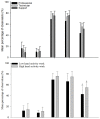Biomechanical Exposure to Upper Extremity Musculoskeletal Disorder Risk Factors in Hospital Laboratories
- PMID: 35010757
- PMCID: PMC8744870
- DOI: 10.3390/ijerph19010499
Biomechanical Exposure to Upper Extremity Musculoskeletal Disorder Risk Factors in Hospital Laboratories
Abstract
Exposure to ergonomic risk factors has been reported for laboratory workers over decades. However, these exposures are not well characterized with respect to the type of laboratory or work organization. This study compared biomechanical exposure to upper extremity (UE) postures and hand activity levels (HALs) in general hospital laboratories by job, work, and laboratory type. The study used observational data gathered using a revised version of the Posture, Activity, Tools, and Handling (PATH) method, generating frequencies of categorized exposures. Eighteen workers were observed in 11 job titles (seven laboratories) in a single hospital by two investigators over a 7 month period. A taxonomy was constructed to categorize the extent to which the laboratory operations were automated. Overall, there were markedly high exposures to postural strain for the distal UE, especially wrist/forearm deviation (73% of observations), gross grasp (71%), and pinch grip (49%). For the HAL categories, 61% of the observations were in the moderate range (3.3-<6.7). Shoulders and elbows tended to remain in the neutral postural range. Posture frequencies were similar among the job categories studied and laboratory types. HAL was higher when the hand was in a pinch grip. Manual operations represented a higher proportion of work time than semi-automated or automated operations. Biomechanical exposure can be documented more extensively and diversely when using the revised PATH approach along with the taxonomy, with respect to exposure variables, such as the type of job, work, or organization in the industry including the hospital laboratories.
Keywords: PATH method; ergonomics; exposure assessment; hospital laboratory; laboratory work.
Conflict of interest statement
The authors declare no conflict of interest. The sponsors, including the NIOSH, had no role in the design, execution, interpretation, or writing of the study. The contents of this paper are solely the responsibility of the authors and do not necessarily represent the official position of the sponsors.
Figures






Similar articles
-
Upper extremity musculoskeletal symptoms among Iranian hand-woven shoe workers.Work. 2020;67(1):129-139. doi: 10.3233/WOR-203258. Work. 2020. PMID: 32955478
-
Are Work-Related Musculoskeletal Disorders Claims Related to Risk Factors in Workplaces of the Manufacturing Industry?Ann Work Expo Health. 2020 Feb 20;64(2):152-164. doi: 10.1093/annweh/wxz084. Ann Work Expo Health. 2020. PMID: 31785202
-
[Risk assessment for upper extremity work related muscoloskeletal disorders in different manufactures by applying six methods of ergonomic analysis].G Ital Med Lav Ergon. 2010 Apr-Jun;32(2):162-73. G Ital Med Lav Ergon. 2010. PMID: 20684437 Italian.
-
Exposure variables in ergonomic epidemiology.Am J Ind Med. 1992;21(1):91-100. doi: 10.1002/ajim.4700210111. Am J Ind Med. 1992. PMID: 1553989 Review.
-
Work-related upper extremity musculoskeletal disorders.Prim Care. 2000 Dec;27(4):845-64. doi: 10.1016/s0095-4543(05)70180-9. Prim Care. 2000. PMID: 11072290 Review.
References
-
- Agrawal P.R., Maiya A.G., Kamath V., Kamath A. Work related musculoskeletal disorders among medical laboratory professionals: A narrative review. Int. J. Res. Med. Sci. 2014;2:1262–1266. doi: 10.5455/2320-6012.ijrms20141105. - DOI
-
- Holm J.W., Mortensen O.S., Gyntelberg F. Upper limb disorders among biomedical laboratory workers using pipettes. Cogent Med. 2016;3:1256849. doi: 10.1080/2331205X.2016.1256849. - DOI
-
- US Bureau of Labor Statistics (US BLS) Rate and Number of Cases of Disorders Associated with Repeated Trauma by Industry in 2001. [(accessed on 12 November 2021)]; Available online: https://www.bls.gov/iif/oshwc/osh/os/ostb1128.pdf.
Publication types
MeSH terms
Grants and funding
LinkOut - more resources
Full Text Sources

